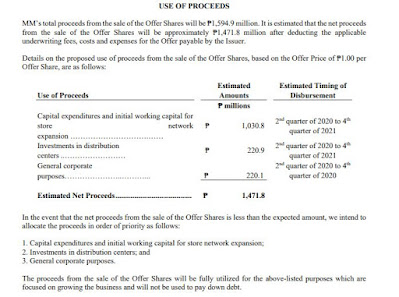My tip: check the Cumulative and Annualized Performance report of the funds and pit them against each other.
These
two indicators are important because they give us an idea on the possible return
on our investment based on historical data, but with no guarantees.
Here
is the “nosebleed” part! By definition, a “cumulative return on an investment (or
cumulative performance)” means the aggregate amount that the investment has
gained or lost over time, independent of the amount of time involved.[1]
While an “annualized performance” is the rate at which an investment grows each
year over the period to arrive at the final valuation.[2]
Let us skip the definitions and go straight to the application.
Below
is the Fund Fact Sheet dated 30 April 2021 of one of the most popular mutual
funds in the Philippines, ATRAM Alpha Opportunity Fund, Inc.
 |
| Snapshot of ATRAM's Fund Fact Sheet dated 30 April 2021 |
Simply
bring your attention to the 5-year (long-term), 3-year(medium-term) and 1- year
(short-term) returns, which give us the following information:
Cumulative -> 5yrs: 5.81%; 3 yrs.: -19.75 %; 1 yr.: 30.49%
Annualized -> 5 yrs.: 1.14%; 3
yrs.: -7.07%; 1 yr.: 30:49%
How
can we interpret the numbers in simplest terms?
Cumulative, it means if you would invest in the fund 5 years ago, and sell it on 30 April 2021, you would earn 5.81% from staying invested over that 5 years; if you started investing 3 years ago, you lost -19.75% over that 3-year span; if you invested just last year, you would generate 30.49% return on investment over 1 year of staying invested. (“kung nag-invest ka sa fund 5 years ago, nag-increase na investment mo ng 5.81% as of 30 April 2021; kung nagsimula ka nag-invest 3 years ago, talo ka na ng -19.75%; kung last year ka lang naginvest, kumita ka na ng 30.49%”).
Annualized, it means your initial investment 5 years ago would grow constantly by 1.14% every year for five years, and the profits were reinvested at the end of each year; if you started investing 3 years ago, your initial investment would lose -7.07% every year for that 3-year span; if you invested just last year, your initial investment would grow by 30.49% after a year. (“kung naginvest ka sa fund 5 years ago, lumalago siya every year ng 1.14% until 30 April 2021; kung naginvest ka 3 years ago, natatalo ang fund ng -7.07% every year; kung last year ka nag-invest, kumita ka ng 30.49% after a year. In short, Compounded Annualized Growth Rate. For easier recall, “kapag annualized performance ang pinaguusapan, isipin niyo na lang na parang utang na compounded ang interest”.)
Understanding
Cumulative and Annualized Performance becomes handy when you are looking for several
mutual funds to invest in, and cannot decide which one is better.
Let us say, you are torn between ATRAM Alpha Opportunity Fund, Inc., and PhilEquity
Fund, which is another popular mutual fund in the Philippines. You can check
PhilEquity’s Fund Fact Sheet dated 30 April 2021 below and compare it with ATRAMS’s.
 |
| Snapshot of PhilEquity's Fund Fact Sheet dated 30 April 2021 |
Based on the information above, the respective performances of the two funds can be summarized as follows:
|
Cumulative |
5 yrs |
3 yrs |
1 yr |
|
ATRAM |
5.81 |
-19.75 |
30.49 |
|
Philequity |
-8.28 |
-16.88 |
11.87 |
|
Annualized |
5 yrs |
3 yrs |
1 yr |
|
ATRAM |
1.14% |
-7.07% |
30.49 |
|
Philequity |
-1.71% |
-5.98% |
11.87 |
Now, ceteris paribus, which fund do you think performs better in the last five years? Which one is worth the risk? You may answer in the comment box below.
Happy Shopping 7.7!
(DISCLAIMER: This is not an investment recommendation.)
You can also check Fitz Villafuerte's vlog on Cumulative Performance vs Annualized Performance on the link below:
[1] Investopedia, Cumulative Return, https://www.investopedia.com/terms/c/cumulativereturn.asp
[2] Investopedia,
Annualized Rate of Return, https://www.investopedia.com/terms/a/annualized-rate.asp





